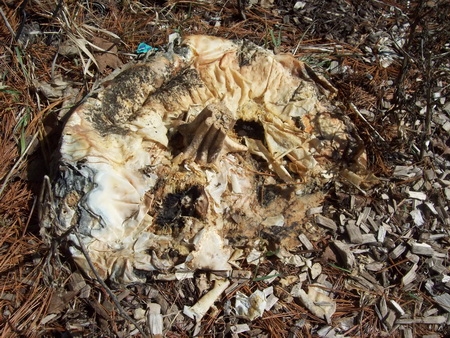Life Cycle of a Pumpkin
This activity began after reading the book “Pumpkin Jack” by Will Hubbell. In this story, a boy places his jack-o-lantern in the garden after it begins to rot and eventually watches as new pumpkins begin to grow the following spring.
To create a meaningful experience from the book, we recreated the story within our own garden space. This garden space is within our playground area and allowed for daily observations and discussions about the process. When major changes occurred, we would photograph the change and add it to a continuous timeline that was set up in our classroom. Children were also asked to predict when changes would occur and measure the changes with rulers. When an animal began eating the pumpkin, research was done to decide what it could be. On a regular basis, clipboards and art materials were brought to the pumpkin where documentation drawings were created by the children. These drawings were displayed, eventually creating a classroom book.
The pumpkin activity allowed for integrating classroom learning into the outdoors. This lesson was extended for an entire year and incorporated every aspect of learning. Science, art, math, and literacy were major parts of this lesson. The children continued to go over the process as time went on, and the following year they wanted to explore the activity again.
I have also used a similar activity in an early childhood setting with children with special needs. The children were all working on facial expressions, social cues and the expression of feelings. Each child had a small pumpkin to draw on with markers. Over several days the children were able to use the pumpkins as a canvas in lessons relating to their own specific goals as laid out in their Individual Education Plans. The final activity was done as a group. The children decorated the pumpkins and had a chance to practice speaking to a group by sharing how they had decorated the pumpkin. Then, the pumpkins were placed into the garden where they could observe and explore the decomposition process.
 In November, after our Halloween festivities were complete, we placed our pumpkin, seeds and all, outside on the playground to investigate what would happen.
In November, after our Halloween festivities were complete, we placed our pumpkin, seeds and all, outside on the playground to investigate what would happen.
 As November went on, we watched as the pumpkin began to decompose. We observed the face shape and color change.
As November went on, we watched as the pumpkin began to decompose. We observed the face shape and color change.
 As December approached, we noticed something was eating the pumpkin. We speculated that it was either a mouse or a squirrel feeding on it when we were gone for the day.
As December approached, we noticed something was eating the pumpkin. We speculated that it was either a mouse or a squirrel feeding on it when we were gone for the day.
 Eventually, at the beginning of December, the pumpkin had decomposed so much that the top fell. We explored what had been happening inside the pumpkin during the decomposition process.
Eventually, at the beginning of December, the pumpkin had decomposed so much that the top fell. We explored what had been happening inside the pumpkin during the decomposition process.
 When the snow finally began falling at the end of December, this is all we could see of our pumpkin. We continued to observe the pumpkin until it was completely covered with snow.
When the snow finally began falling at the end of December, this is all we could see of our pumpkin. We continued to observe the pumpkin until it was completely covered with snow.
 In February, when the snow began to melt, our pumpkin was looking different. It had changed color and flattened with all the snow on top. We were excited to see the changes!
In February, when the snow began to melt, our pumpkin was looking different. It had changed color and flattened with all the snow on top. We were excited to see the changes!
 In March, when all the snow had melted, there was very little left of our pumpkin. When we lifted up the top, we saw all the seeds and couldn’t wait to plant them!
In March, when all the snow had melted, there was very little left of our pumpkin. When we lifted up the top, we saw all the seeds and couldn’t wait to plant them!
- We learned about the decomposition process.
- We observed the seasons as it related to our garden.
- We explored the life cycle of a pumpkin.
- We integrated our learning into the outdoors.